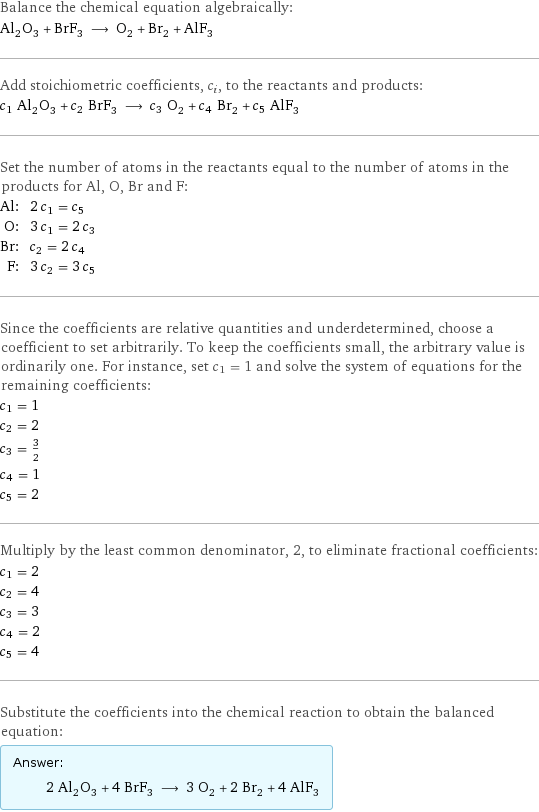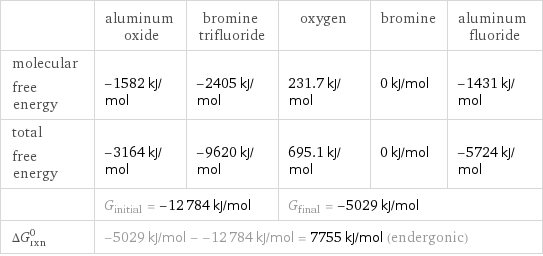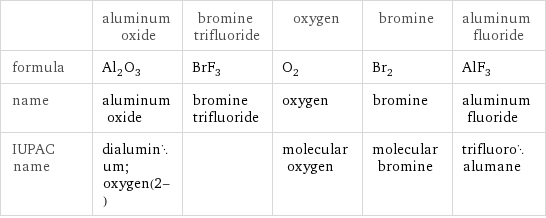Input interpretation

Al_2O_3 aluminum oxide + BrF_3 bromine trifluoride ⟶ O_2 oxygen + Br_2 bromine + AlF_3 aluminum fluoride
Balanced equation

Balance the chemical equation algebraically: Al_2O_3 + BrF_3 ⟶ O_2 + Br_2 + AlF_3 Add stoichiometric coefficients, c_i, to the reactants and products: c_1 Al_2O_3 + c_2 BrF_3 ⟶ c_3 O_2 + c_4 Br_2 + c_5 AlF_3 Set the number of atoms in the reactants equal to the number of atoms in the products for Al, O, Br and F: Al: | 2 c_1 = c_5 O: | 3 c_1 = 2 c_3 Br: | c_2 = 2 c_4 F: | 3 c_2 = 3 c_5 Since the coefficients are relative quantities and underdetermined, choose a coefficient to set arbitrarily. To keep the coefficients small, the arbitrary value is ordinarily one. For instance, set c_1 = 1 and solve the system of equations for the remaining coefficients: c_1 = 1 c_2 = 2 c_3 = 3/2 c_4 = 1 c_5 = 2 Multiply by the least common denominator, 2, to eliminate fractional coefficients: c_1 = 2 c_2 = 4 c_3 = 3 c_4 = 2 c_5 = 4 Substitute the coefficients into the chemical reaction to obtain the balanced equation: Answer: | | 2 Al_2O_3 + 4 BrF_3 ⟶ 3 O_2 + 2 Br_2 + 4 AlF_3
Structures

+ ⟶ + +
Names

aluminum oxide + bromine trifluoride ⟶ oxygen + bromine + aluminum fluoride
Reaction thermodynamics
Gibbs free energy

| aluminum oxide | bromine trifluoride | oxygen | bromine | aluminum fluoride molecular free energy | -1582 kJ/mol | -2405 kJ/mol | 231.7 kJ/mol | 0 kJ/mol | -1431 kJ/mol total free energy | -3164 kJ/mol | -9620 kJ/mol | 695.1 kJ/mol | 0 kJ/mol | -5724 kJ/mol | G_initial = -12784 kJ/mol | | G_final = -5029 kJ/mol | | ΔG_rxn^0 | -5029 kJ/mol - -12784 kJ/mol = 7755 kJ/mol (endergonic) | | | |
Equilibrium constant
![Construct the equilibrium constant, K, expression for: Al_2O_3 + BrF_3 ⟶ O_2 + Br_2 + AlF_3 Plan: • Balance the chemical equation. • Determine the stoichiometric numbers. • Assemble the activity expression for each chemical species. • Use the activity expressions to build the equilibrium constant expression. Write the balanced chemical equation: 2 Al_2O_3 + 4 BrF_3 ⟶ 3 O_2 + 2 Br_2 + 4 AlF_3 Assign stoichiometric numbers, ν_i, using the stoichiometric coefficients, c_i, from the balanced chemical equation in the following manner: ν_i = -c_i for reactants and ν_i = c_i for products: chemical species | c_i | ν_i Al_2O_3 | 2 | -2 BrF_3 | 4 | -4 O_2 | 3 | 3 Br_2 | 2 | 2 AlF_3 | 4 | 4 Assemble the activity expressions accounting for the state of matter and ν_i: chemical species | c_i | ν_i | activity expression Al_2O_3 | 2 | -2 | ([Al2O3])^(-2) BrF_3 | 4 | -4 | ([BrF3])^(-4) O_2 | 3 | 3 | ([O2])^3 Br_2 | 2 | 2 | ([Br2])^2 AlF_3 | 4 | 4 | ([AlF3])^4 The equilibrium constant symbol in the concentration basis is: K_c Mulitply the activity expressions to arrive at the K_c expression: Answer: | | K_c = ([Al2O3])^(-2) ([BrF3])^(-4) ([O2])^3 ([Br2])^2 ([AlF3])^4 = (([O2])^3 ([Br2])^2 ([AlF3])^4)/(([Al2O3])^2 ([BrF3])^4)](../image_source/eb848c4e38e350168eab8ad72ae7e585.png)
Construct the equilibrium constant, K, expression for: Al_2O_3 + BrF_3 ⟶ O_2 + Br_2 + AlF_3 Plan: • Balance the chemical equation. • Determine the stoichiometric numbers. • Assemble the activity expression for each chemical species. • Use the activity expressions to build the equilibrium constant expression. Write the balanced chemical equation: 2 Al_2O_3 + 4 BrF_3 ⟶ 3 O_2 + 2 Br_2 + 4 AlF_3 Assign stoichiometric numbers, ν_i, using the stoichiometric coefficients, c_i, from the balanced chemical equation in the following manner: ν_i = -c_i for reactants and ν_i = c_i for products: chemical species | c_i | ν_i Al_2O_3 | 2 | -2 BrF_3 | 4 | -4 O_2 | 3 | 3 Br_2 | 2 | 2 AlF_3 | 4 | 4 Assemble the activity expressions accounting for the state of matter and ν_i: chemical species | c_i | ν_i | activity expression Al_2O_3 | 2 | -2 | ([Al2O3])^(-2) BrF_3 | 4 | -4 | ([BrF3])^(-4) O_2 | 3 | 3 | ([O2])^3 Br_2 | 2 | 2 | ([Br2])^2 AlF_3 | 4 | 4 | ([AlF3])^4 The equilibrium constant symbol in the concentration basis is: K_c Mulitply the activity expressions to arrive at the K_c expression: Answer: | | K_c = ([Al2O3])^(-2) ([BrF3])^(-4) ([O2])^3 ([Br2])^2 ([AlF3])^4 = (([O2])^3 ([Br2])^2 ([AlF3])^4)/(([Al2O3])^2 ([BrF3])^4)
Rate of reaction
![Construct the rate of reaction expression for: Al_2O_3 + BrF_3 ⟶ O_2 + Br_2 + AlF_3 Plan: • Balance the chemical equation. • Determine the stoichiometric numbers. • Assemble the rate term for each chemical species. • Write the rate of reaction expression. Write the balanced chemical equation: 2 Al_2O_3 + 4 BrF_3 ⟶ 3 O_2 + 2 Br_2 + 4 AlF_3 Assign stoichiometric numbers, ν_i, using the stoichiometric coefficients, c_i, from the balanced chemical equation in the following manner: ν_i = -c_i for reactants and ν_i = c_i for products: chemical species | c_i | ν_i Al_2O_3 | 2 | -2 BrF_3 | 4 | -4 O_2 | 3 | 3 Br_2 | 2 | 2 AlF_3 | 4 | 4 The rate term for each chemical species, B_i, is 1/ν_i(Δ[B_i])/(Δt) where [B_i] is the amount concentration and t is time: chemical species | c_i | ν_i | rate term Al_2O_3 | 2 | -2 | -1/2 (Δ[Al2O3])/(Δt) BrF_3 | 4 | -4 | -1/4 (Δ[BrF3])/(Δt) O_2 | 3 | 3 | 1/3 (Δ[O2])/(Δt) Br_2 | 2 | 2 | 1/2 (Δ[Br2])/(Δt) AlF_3 | 4 | 4 | 1/4 (Δ[AlF3])/(Δt) (for infinitesimal rate of change, replace Δ with d) Set the rate terms equal to each other to arrive at the rate expression: Answer: | | rate = -1/2 (Δ[Al2O3])/(Δt) = -1/4 (Δ[BrF3])/(Δt) = 1/3 (Δ[O2])/(Δt) = 1/2 (Δ[Br2])/(Δt) = 1/4 (Δ[AlF3])/(Δt) (assuming constant volume and no accumulation of intermediates or side products)](../image_source/5f9df5b91964c590e7c12b8e664a4123.png)
Construct the rate of reaction expression for: Al_2O_3 + BrF_3 ⟶ O_2 + Br_2 + AlF_3 Plan: • Balance the chemical equation. • Determine the stoichiometric numbers. • Assemble the rate term for each chemical species. • Write the rate of reaction expression. Write the balanced chemical equation: 2 Al_2O_3 + 4 BrF_3 ⟶ 3 O_2 + 2 Br_2 + 4 AlF_3 Assign stoichiometric numbers, ν_i, using the stoichiometric coefficients, c_i, from the balanced chemical equation in the following manner: ν_i = -c_i for reactants and ν_i = c_i for products: chemical species | c_i | ν_i Al_2O_3 | 2 | -2 BrF_3 | 4 | -4 O_2 | 3 | 3 Br_2 | 2 | 2 AlF_3 | 4 | 4 The rate term for each chemical species, B_i, is 1/ν_i(Δ[B_i])/(Δt) where [B_i] is the amount concentration and t is time: chemical species | c_i | ν_i | rate term Al_2O_3 | 2 | -2 | -1/2 (Δ[Al2O3])/(Δt) BrF_3 | 4 | -4 | -1/4 (Δ[BrF3])/(Δt) O_2 | 3 | 3 | 1/3 (Δ[O2])/(Δt) Br_2 | 2 | 2 | 1/2 (Δ[Br2])/(Δt) AlF_3 | 4 | 4 | 1/4 (Δ[AlF3])/(Δt) (for infinitesimal rate of change, replace Δ with d) Set the rate terms equal to each other to arrive at the rate expression: Answer: | | rate = -1/2 (Δ[Al2O3])/(Δt) = -1/4 (Δ[BrF3])/(Δt) = 1/3 (Δ[O2])/(Δt) = 1/2 (Δ[Br2])/(Δt) = 1/4 (Δ[AlF3])/(Δt) (assuming constant volume and no accumulation of intermediates or side products)
Chemical names and formulas

| aluminum oxide | bromine trifluoride | oxygen | bromine | aluminum fluoride formula | Al_2O_3 | BrF_3 | O_2 | Br_2 | AlF_3 name | aluminum oxide | bromine trifluoride | oxygen | bromine | aluminum fluoride IUPAC name | dialuminum;oxygen(2-) | | molecular oxygen | molecular bromine | trifluoroalumane